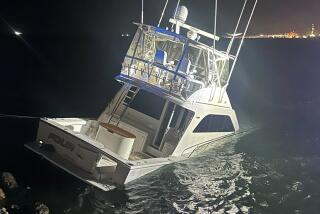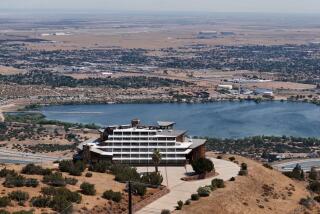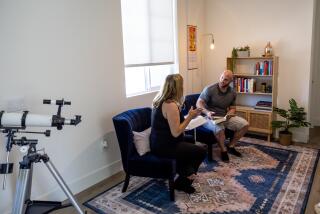Ahoy, honey, I’m home
- Share via
When Diane and Noel Diotte began dreaming of leaving their San Gabriel Valley condominium to live full time on their 34-foot sloop, one question nagged at them. What would they do with all their stuff?
“A year later, my husband asked what we had in storage and I couldn’t even remember,” said Diane Diotte, an executive for an El Segundo-based software company. “That’s how quickly you realize just how little possessions matter.”
What is important to people such as the Diottes, who discovered this serene and simple life years ago, is the lifestyle living on the water affords.
“It’s hard to describe,” said Diotte, who has called Redondo Beach’s King Harbor her home for about nine years. “There’s a sense of well-being that comes from living so close to nature and from learning to hold on to only those things in life that really matter.”
But opportunities to experience this alternative to traditional housing are getting harder to find in Southern California. As the price of living on land has continued to rise, the costs of living on water have remained comparatively affordable. And demand for slips for “live-aboards” -- the nickname for the people who live full time on boats and for those boats themselves -- remains high at a time when local marinas are limiting them.
“I’ve pretty much stopped accepting new live-aboards,” said Horia Ispas, dock master of three marinas in Marina del Rey. “I haven’t written them off entirely, but unless it’s a big boat with its own bathroom and things, I’m staying away from them.”
Some of the people who use live-aboards as low-cost housing have blighted marinas in recent years, Ispas said. “We’ve had problems.”
For that reason, some other marinas in such places as Marina del Rey and Newport Beach have stopped accepting live-aboards altogether.
“Most of the marinas here, if not all of them, are phasing out live-aboards,” said Chris Miller, who works for the Harbor Resources Department of Newport Beach. The city, however, still allows live-aboards on offshore moorings that are rented as places to berth boats.
Although Newport Beach allows up to 51 live-aboards at its offshore moorings, only about 30 boat owners currently opt for this rugged lifestyle. With no access to electricity at a dock, most mooring live-aboards generate their own power with solar panels. Residents must regularly bring their boats to pump-out stations to empty sewage holds. To get to and from the shore, they use dinghies like other people use cars. Despite the inconveniences, some wouldn’t have it any other way.
“When I got out of college, I thought it would be fun to live on a boat,” said Mark Sites, a live-aboard at Newport Harbor and owner of Newport Beach-based Intercoastal Dredging. “That was 27 years ago. It’s just a nice way to live. I have a great view. It’s very peaceful.”
For Bobby Pitz, the live-aboard lifestyle is about socializing with friends -- many of them divorced and single men like him -- enjoying ocean views, occasionally sailing off to Catalina and even dining on fresh lobster he catches himself, all for about $400 a month.
“My boat’s paid for, so for me it’s actually cheaper than getting an apartment,” said Pitz, a live-aboard for about four years at King Harbor.
Marinas that permit live-aboards charge an extra fee on top of the regular slip charge. The number of people who can live on a vessel varies by marina and boat size, but most cap occupancy at two per boat.
King Harbor charges an additional $175 for a single person to live on his or her boat. For a 40-foot boat, this brings the cost of the slip to about $500 a month. Normally the fees include electricity hookups at the dock and access to showers and bathrooms. Slips in Marina del Rey often run higher. A 40-foot slip is about $490 before the live-aboard fee of about $270. And then there is the cost of a boat, which can range anywhere from $2,000 to several million dollars.
While Newport and Marina del Rey are moving away from live-aboards, waiting lists at other marinas are growing. Long Beach Marina, where about 10% of the 1,800 slips are live-aboards, has about a three-year waiting list. The wait for a live-aboard slip at King Harbor also can be about three years.
Marinas allowing live-aboards usually like to cap them at about 10% of total slips. King Harbor has about 110 of its 850 slips in use by live-aboards -- a number the marina would like to scale back, says operations manager Michael Aaker. “You have to keep it reasonable.”
Caps on the number of live-aboards combined with the marina’s selective admission criteria keep blighting effects at bay, he said. “We have very strict credit requirements.”
But even as marinas are limiting live-aboards, these full-time boat dwellers continue to play an important role.
“I think that moving away from live-aboards altogether would be foolish,” said Cindy Ryan, office manager of the California Yacht Marina in San Pedro, where about 45 of the 889 slips are used by live-aboards.
“Live-aboards are your eyes and ears,” Ryan said. “They’re like a neighborhood watch. This is their home.”
*
(BEGIN TEXT OF INFOBOX)
The cost of living on the water
Boats at least 40 feet long with separate sleeping quarters are best for live-aboards, experts say. Powerboats are better than sailboats on which masts and other equipment take up cabin space.
Here is an example of the estimated costs and other financial considerations for a classic live-aboard choice, a 1991 42-foot Carver 4207 Aft Cabin motorboat:
Price: $180,000 (purchased resale)
Monthly payment on a typical 20-year loan: $950 (financing 80% at a 5% annual rate)
Slip rental: King Harbor, $500 a month; Marina del Rey, $760 a month
Insurance: $145 a month
Maintenance: $9,000 a year average. (Estimate about 5% of the boat’s total cost for annual maintenance and repairs.)
Living area: About 500 square feet
Tax benefits: Some boats with eating, sleeping and lavatory facilities can qualify as primary residences for tax purposes, with write-offs for interest, maintenance and other costs.


